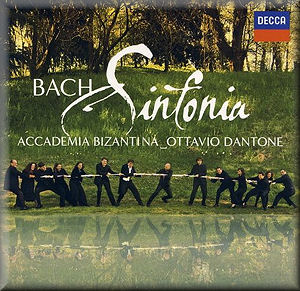 |
 |
|


alternatively
CD: MDT
AmazonUK
AmazonUS
|
Johann Sebastian BACH (1685-1750)
Sinfonia from Cantata BWV 29 ‘Wir danken dir, Gott’ [3:35]
Sinfonia Cantata BWV 150 ‘Nach dir, Herr, verlanget mich’ [2:29]
Sinfonia from Cantata BWV 42 ‘Am Abend aber desselbigen verwirret’
[6:24]
Concerto from Cantata BWV 35 ‘Geist und Seele wird verwirret’ [5:16]
Sinfonia from Cantata BWV 156 ‘Ich steh mit einem Fuss im Grabe’
[2:35]
Sinfonia from Cantata BWV 35 ‘Geist und Seele wird verwirret’ [3:21]
Sinfonia from Cantata BWV 196 ‘Der Herr denket an uns’ (Wedding
Cantata) [2:29]
Sonata from Cantata BWV 31 ‘Der Himmel lacht, die Erde jubilieret’
[2:39]
Concerto from Cantata BWV 152 ‘Tritt auf die Glaubensbahn’ [3:15]
Sinfonia from Cantata BWV 169 ‘Gott soll allein mein Herze haben’
[8:54]
Sinfonia from Cantata BWV 12 ‘Weinen, Klagen, sorgen, Zagen’ [2:23]
Sinfonia from Cantata BWV 52 ‘Falsche Welt, dir trau ich nicht’
[4:06]
Concerto from Cantata BWV 142 ‘Uns ist ein Kind geboren’ [1:25]
[Allegro] from Cantata BWV 146 ‘Wir müssen durch viel Trübsal’ [7:55]
Sonata Concerto from Cantata BWV 182 ‘Himmelskönig, sei willkommen’[2:24]
Sinfonia Concerto from Cantata BWV 174 ‘Ich liebe den Höchsten’
[6:05]
Sinfonia from Cantata BWV 21 ‘Ich hatte viel Bekümmernis’ [2:47]
Sinfonia from Cantata BWV 18 ‘Gleichwie der Regen’ [2:52]
Sinfonia from Cantata BWV 75 ‘Die Elenden sollen essen’ [2:30]
 Accademia Bizantina/Ottavio Dantone
Accademia Bizantina/Ottavio Dantone
rec. 3-7 January 2011, Church of San Girolamo, Bagnacavallo, Ravenna
 DECCA 478 2718 [73:24]
DECCA 478 2718 [73:24] 
|
|
|
I greatly admired and am still a big fan of Ottavio Dantone’s
Vivaldi recordings (see review),
so needed little persuading to explore his take on J.S. Bach.
We’ve come across a few of these separate Sinfonia movements
in a recent ECM release with Heinz Holliger and the Camerata
Bern (see review),
and while they pop up now and then as fillers in orchestral
programmes I don’t remember seeing quite as many collected onto
one CD. As Clifford Bartlett points out in the booklet notes,
“Bach did not habitually preface his cantatas with an orchestral
movement”, and so this programme only misses out the earlier
short mini-prologues, and those from Cantatas 4 and 106, which
are deemed “too integral to the cantatas as a whole to be played
in isolation.”
This is a point which can be made for those who are familiar
with Bach’s cantatas. In this programme there is sometimes a
sense in which the ‘and next’ moments feel truncated – the expectation
of a human voice or chorus denied. This isn’t so much of an
issue for most of us who only dip into the huge field of Bach’s
cantatas from time to time, and for those who are unfortunately
allergic to singing this kind of selection is a godsend. One
can perhaps see it as the antithesis or complementary to something
voice-heavy like Masaaki Suzuki’s A Choral Year with J.S.
Bach on the BIS label (see review).
As you would expect from the Accademia Bizantina, these are
period-style performances with clean lines and little or no
vibrato in the strings. There is always continuo of one kind
or another, the bassoon is considered standard ‘whether or not
it was notated’, and there are healthy doses of organ, rather
less prominent harpsichord in some pieces. My only real beef
with this recording is in fact the organ. This is a ‘portativo’
or small organ with limited tonal colour and a rather penetrating
treble sound which dominates in the works where it has a solo
role. The opening joyous Sinfonia BWV 29 ‘Wir danken dir,
Gott’ is a representative example, and is almost more off-putting
than inviting. This may not bother most people and I don’t want
to labour the point, but every time it leaps out at us my heart
sinks just a little.
Highlights for me include the trumpet and drum succulence of
the Sonata BWV 31 ‘Der Himmel lacht’ followed immediately
by the whispering busy-ness of the Concerto BWV 152 ‘Tritt
auf die Glaubensbahn’. Comparing the Sinfonia BWV 21
‘Ich hatte viel Bekümmernis’ with the Holliger CD I mentioned
earlier I don’t feel as much of an emotional charge from the
Accademia Bizantina, though they still create a nicely grieving
mood, the organ noodling away in the lower registers but with
an appropriately more mellow stop. This is mirrored earlier
on by BWV 12, and compliments go to the oboist in both
cases. You can also be prepared to hear things you will have
heard elsewhere. For instance the Sinfonia BWV 52 ‘Falsche
Welt, dir trau ich nicht’ is lifted almost straight from
Bach’s Brandenburg Concerto No.1, giving the horns a
chance to shine. This is followed by the short Concerto BWV
142 ‘Uns ist ein Kind geboren’ which has duets from recorders
and oboes, which in turn sandwiches the orchestral Allegro
BWV 146 ‘Wir müssen durch viel Trübsal’ which comes from
the Harpsichord Concerto BWV 1052 in D minor – the solo
in the hands of ‘it’s that organ again’.
This CD is a joyous project and a very nice thing to have around.
It looks as if the band had fun with the photo shoot, though
note the lack of reflection of the players inside the case –
that precariously close water’s edge is a photoshop illusion.
I was hoping the effect of having all of these pieces together
in one place would be something akin to discovering a ‘new’
Bach work – something which felt like an extra-extended suite
or even something vaguely symphonic, but this isn’t quite the
case. Care has however been taken to structure the programme
so that these is a reasonable amount of contrast, and with gorgeous
playing, bags of excellent music and a very fine recording this
is an easily recommendable release.
Dominy Clements
|
|

